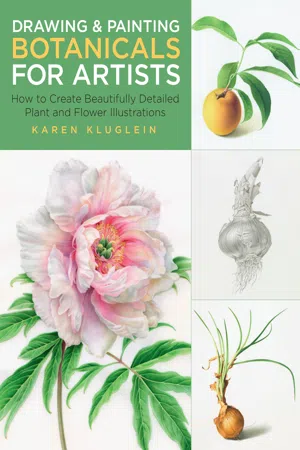
Drawing and Painting Botanicals for Artists
How to Create Beautifully Detailed Plant and Flower Illustrations
- 160 pages
- English
- ePUB (mobile friendly)
- Available on iOS & Android
Drawing and Painting Botanicals for Artists
How to Create Beautifully Detailed Plant and Flower Illustrations
About This Book
Originally developed in the 18th century as a visual supplement to botanical nomenclature, botanical illustration and art uniquely fuse art and science by documenting the parts, details, and life cycles of plant species. In Drawing and Painting Botanicals for Artists, eminent botanical artist and veteran workshop instructor Karen Kluglein reveals her secrets for rendering leaves, flowers, berries, and branches both accurately and beautifully. The book begins with a brief history of the art form, followed by guidance on developing observational skills for this genre, key botanical terms and concepts, and the differences among botanical illustration, botanical art, and flower painting. The chapters that follow offer detailed guidance and demonstrations for drawing and painting botanicals in a variety of mediums:
- Drawing. Explore loose gestural drawing, precise measuring and rendering, and working from photographs with graphite, colored pencil, finepoint markers, pen and ink, and silverpoint.
- Painting. Master color mixing, washes, layering, gradations, values, and adding details in watercolor, gouache, and acrylic, plus guidance on adding "personality" to your work and knowing when a painting is done.
Drawing and Painting Botanicals for Artists shows artists at all skill levels how to translate careful observations into stunning works of art. The For Artists series expertly guides and instructs artists at all skill levels who want to develop their classical drawing and painting skills and create realistic and representational art.
Frequently asked questions
Information
1
DRAWING
Botanicals

MEDIUMS AND SUPPLIES


GRAPHITE PENCILS

COLORED PENCILS
Table of contents
- Cover
- Title Page
- Contents
- Introduction
- 1 Drawing Botanicals
- 2 Painting Botanicals
- Final Thoughts
- Resources
- Acknowledgments
- About the Author
- Index
- Dedication
- Copyright